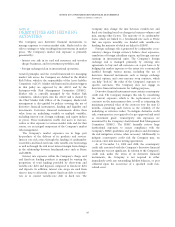American Express 2009 Annual Report Download - page 102
Download and view the complete annual report
Please find page 102 of the 2009 American Express annual report below. You can navigate through the pages in the report by either clicking on the pages listed below, or by using the keyword search tool below to find specific information within the annual report.
NOTES TO CONSOLIDATED FINANCIAL STATEMENTS
AMERICAN EXPRESS COMPANY
derivative continue to be recorded through earnings but the
hedged asset or liability is no longer adjusted for changes in
fair value. The existing basis adjustment of the hedged asset or
liability is then amortized or accreted as an adjustment to
yield over the remaining life of that asset or liability.
The following table summarizes the impact on the Consolidated Financial Statements of fair value hedges associated with the
Company’s fixed-rate long-term debt described above for the years ended December 31:
Statement of Income
Derivative contract (loss) gain Hedged item gain (loss)
Ineffective net
(losses) gains
(Millions)
Amount
recognized
Amount
recognized
Derivative relationship Location 2009 2008 Location 2009 2008 2009 2008
Interest rate contracts Other, net expenses $(446) $967 Other, net expenses $437 $(898) $(9) $69
CASH FLOW HEDGES
A cash flow hedge involves a derivative financial instrument
designated to hedge the Company’s exposure to variable
future cash flows attributable to a particular risk of an existing
recognized asset or liability, or a forecasted transaction. The
Company hedges existing long-term variable-rate debt, the
rollover of short-term borrowings and the anticipated
forecasted issuance of additional funding through the use of
derivative financial instruments, primarily interest rate swaps.
These instruments effectively convert floating-rate debt to
fixed-rate debt for the duration of the swap. As of
December 31, 2009 and 2008, the Company hedged $1.6
billion and $4.7 billion, respectively, of its floating debt using
interest rate swaps.
For derivatives that qualify as cash flow hedges, the
effective portion of the gain or loss on the derivatives are
recorded in accumulated other comprehensive (loss) income
and reclassified into earnings when the hedged cash flows are
recognized in earnings. The amount that is reclassified into
earnings is presented in the Consolidated Statements of
Income with the hedged instrument or transaction impact,
primarily in interest expense. Any ineffective portion of the
gain or loss on the derivatives is reported as a component of
other, net expenses. If a cash flow hedge is de-designated or
terminated prior to maturity, the amount previously recorded
in accumulated other comprehensive (loss) income is
recognized into earnings over the period that the hedged item
impacts earnings. If a hedge relationship is discontinued
because it is probable that the forecasted transaction will not
occur according to the original strategy, any related amounts
previously recorded in accumulated other comprehensive
(loss) income are recognized into earnings immediately.
In the normal course of business, as the hedged cash flows
are recognized into earnings, the Company expects to
reclassify $32 million of net pretax losses on derivative
instruments from accumulated other comprehensive (loss)
income into earnings during the next 12 months.
NET INVESTMENT HEDGES
A net investment hedge is used to hedge future changes in
currency exposure of a net investment in a foreign operation.
The Company primarily designates foreign currency
derivatives, typically foreign exchange forwards, and on
occasion foreign currency denominated debt, as hedges of net
investments in certain foreign operations. These instruments
reduce exposure to changes in currency exchange rates on the
Company’s investments in non-U.S. subsidiaries. The
effective portion of the gain or loss on net investment hedges
are recorded in accumulated other comprehensive (loss)
income as part of the cumulative translation adjustment. Any
ineffective portion of the gain or loss on net investment
hedges is recognized in other, net expenses during the period
of change.
100
























